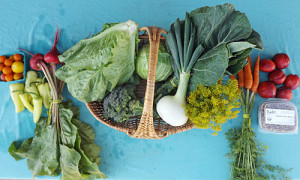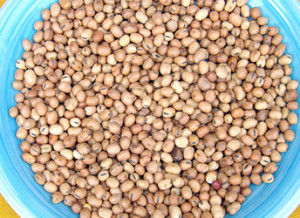Week 5, August 8
Both boxes have: Sweet peppers, broccoli, Walla Walla onion, Romaine, nectarines, pickling dill flower
The Small box also has: Cucumber, green cabbage
The Standard box also has: Chiogga beets & greens, collards, dried Diana fava beans, bunched carrots
The sweet peppers in your boxes this week come from Alvarez Farm, an organic farm in Mabton, WA, that specializes in 155 varieties of sweet and hot peppers.
Peppers are high on the list of veggies that you should only eat organic. They are thin-skinned and on conventional farms they are sprayed several times in the course of ripening to prevent pest and fungus damage. These chemicals are absorbed through the thin skins, and no amount of washing will remove them.
But Hilario Alvarez farms organically, so enjoy these peppers without worry!
Recipe for Roasted Pepper & Onion Wrap
Pickling Dill Flower
This is a little bonus for your box. We had a bumper crop and wanted to pass the bounty on to you. If you make pickles, you probably know what to do with it. But if you don’t, chop up the flowering heads into salad dressings, marinades, or in cold salads such as potato salad or coleslaw.
Use the flowers and fronds to make dill-infused vinegar. Just pack the pickling dill heads into a glass bottle or jar and fill it to the top with your favorite vinegar. Then cover and let sit in a cool, dark pantry for about six weeks. Besides making a great base for salad dressings, the dill vinegar can be poured over sliced cucumbers and onions with a bit of fresh ground pepper for a refreshingly cool summer salad.
Fresh dill is also a natural flavor companion for fish, especially salmon. Use snippets of the flowers to garnish any fish dish, or mash them up with butter or olive oil, salt and pepper, and season chicken or fish accordingly.
Dill flowers do start to wilt shortly after being picked, but retain their robust flavor and if kept wrapped in a damp towel or plastic bag, will keep for a week or more in your fridge.
Diana Fava Beans
Fava beans are one of the best sources of vegetable protein ever. Thoroughly rinse and inspect the beans, picking out small pebbles or damaged beans that made it through our seed cleaner, and rinse off the diatomaceous earth we have dusted them with as a safeguard against bean weevils in storage. Dried Diana fava beans can be prepared as you would pinto beans. Soak 1 part beans in 2 parts water for 6+ hours. Strain, rinse and combine 1 part soaked beans in 2 parts fresh water. Bring to a boil, then simmer for about 65 minutes. Allow for additional cooking time if the beans have not been pre‐soaked. Favas become very tender when simmered on low in a crockpot over‐ night. Dianas are a very hard bean (which makes them a good storage bean) with a resilient seed coat, so make sure the outer skins are very tender. If necessary, add additional water.
You can use your beans to make hummus or half way through cooking, season with salt, chili powder, cumin, coriander, bay leaf, garlic, peppers and/or onions. Add a couple of cut up tomatoes towards the end of the cooking process, and use as a side dish or in soups and stews.


